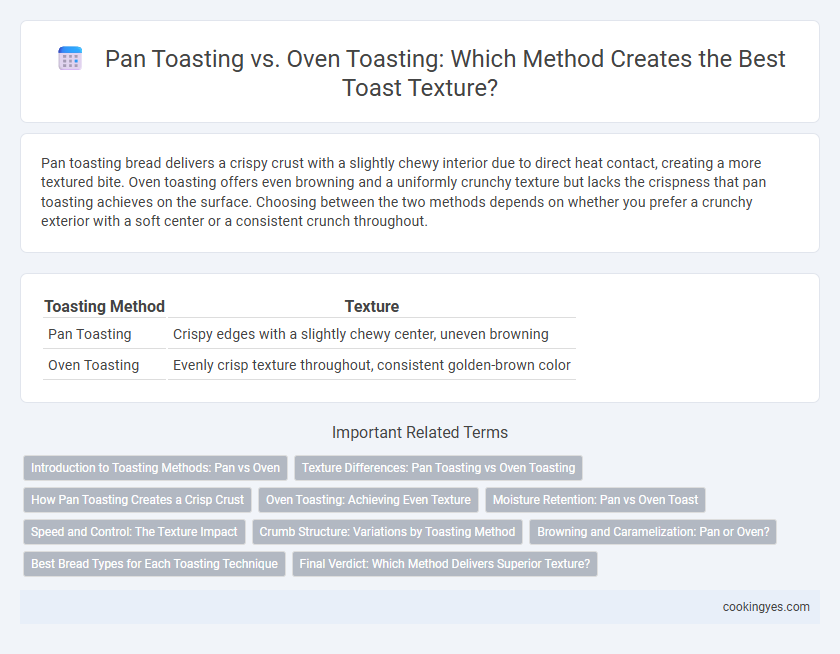Pan toasting bread delivers a crispy crust with a slightly chewy interior due to direct heat contact, creating a more textured bite. Oven toasting offers even browning and a uniformly crunchy texture but lacks the crispness that pan toasting achieves on the surface. Choosing between the two methods depends on whether you prefer a crunchy exterior with a soft center or a consistent crunch throughout.
Table of Comparison
| Toasting Method | Texture |
|---|---|
| Pan Toasting | Crispy edges with a slightly chewy center, uneven browning |
| Oven Toasting | Evenly crisp texture throughout, consistent golden-brown color |
Introduction to Toasting Methods: Pan vs Oven
Pan toasting offers direct heat application, resulting in a crispier exterior and a more controlled browning process. Oven toasting provides even heat distribution, creating uniform texture but with less immediate control over crispiness. Both methods influence the final texture of toast, with pan toasting favored for a crunchier bite and oven toasting preferred for consistent color and warmth.
Texture Differences: Pan Toasting vs Oven Toasting
Pan toasting bread produces a crisp, golden crust with a slightly uneven texture due to direct contact with the hot surface, enhancing Maillard browning and creating a satisfying crunch. Oven toasting yields a more uniform, evenly browned texture with a consistent crispness throughout, as heat surrounds the bread, allowing moisture to evaporate gradually. The choice between pan and oven toasting significantly impacts the texture, making pan toasting ideal for a rustic crunch and oven toasting perfect for balanced, consistent toast.
How Pan Toasting Creates a Crisp Crust
Pan toasting bread produces a crisp crust by directly applying heat to the surface, promoting Maillard reactions that develop deep flavor and crunch. This method allows precise control over browning and texture, creating a golden, crunchy exterior while maintaining a soft interior. In contrast, oven toasting heats more evenly but often results in a drier, less textured crust without the intense crispness from pan contact.
Oven Toasting: Achieving Even Texture
Oven toasting ensures even heat distribution, resulting in a uniformly crisp texture throughout the bread. Unlike pan toasting, which can create hot spots and uneven browning, oven toasting allows controlled temperature settings to achieve consistent crunchiness. This method is ideal for thicker slices or multiple pieces, providing reliable texture without the need for constant attention.
Moisture Retention: Pan vs Oven Toast
Pan toasting preserves moisture better by applying direct, controlled heat that crisps the surface while keeping the bread's interior soft and tender. Oven toasting uses dry, surrounding heat that evenly browns the bread but often dries it out, reducing moisture retention. For optimal texture with a balance of crispiness and softness, pan toasting is superior to oven toasting in maintaining moisture.
Speed and Control: The Texture Impact
Pan toasting offers faster heat application and precise control over browning, allowing for a crisp exterior while maintaining a soft interior in bread slices. Oven toasting provides even, consistent heat that can enhance uniform texture but takes longer to achieve desired crispness. Texture impact depends on speed and control, with pan toasting ideal for quick, customized crunch and oven toasting suited for steady, thorough toasting.
Crumb Structure: Variations by Toasting Method
Pan toasting enhances crumb structure by creating a crisp outer layer with a tender, moist interior, resulting from direct, high-heat contact. Oven toasting produces a more even, drier crumb texture throughout due to uniform radiant heat exposure. The choice between pan and oven toasting significantly impacts the balance of crispness and crumb softness in toasted bread.
Browning and Caramelization: Pan or Oven?
Pan toasting delivers superior browning and caramelization due to direct contact with the hot surface, allowing Maillard reactions to develop rich, complex flavors and a crisp, golden crust. Oven toasting offers even heat distribution that toasts bread uniformly but produces less intense surface caramelization and a softer texture. For maximum crunch and deep caramel notes, pan toasting is preferable, while oven toasting excels for gentle browning and consistent texture.
Best Bread Types for Each Toasting Technique
Pan toasting best suits dense breads like sourdough and rye, as the direct heat creates a crispy crust while maintaining a chewy interior. Oven toasting excels with airy breads such as baguettes and brioche, allowing even heat distribution to produce a uniformly crunchy texture. Choosing the right toasting technique enhances the bread's natural qualities, optimizing flavor and mouthfeel.
Final Verdict: Which Method Delivers Superior Texture?
Pan toasting offers superior texture by creating a crisp, golden crust with a slightly chewy interior due to direct heat and controlled cooking time. Oven toasting provides even browning but can result in a drier, more uniform crunch lacking the nuanced contrast found in pan-toasted bread. For optimal texture, pan toasting delivers a more complex and satisfying bite.
Pan Toasting vs Oven Toasting for Texture Infographic

 cookingyes.com
cookingyes.com